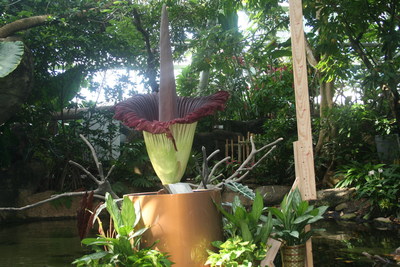Guests Will Be Blown Away as Morticia Returns
Staff at the Moody Gardens
Rainforest Pyramid are watching closely and holding their noses in
anticipation of another opportunity to see the Amorphophallus titanum,
or Giant Corpse Flower, named Morticia bloom. An extraordinary
occurrence, this is the second time for the flower to bloom. It bloomed
for the first time in June 2012. Native only to Sumatra, Indonesia, it
is rare for the Corpse Flower to bloom in its native habitat, but it is
extremely rare for it to do so in cultivation. Morticia's bloom will be
only the fifth in the state of Texas. Moody Gardens will have extended
operating hours once the plant is in full bloom for guests to experience
this powerfully pungent and beautiful occurrence.

The common name,
Corpse Flower, originates from the unpleasant odor the plant emits
during flowering. The strong smell and color are similar to rotting
flesh, which attracts its pollinators, carrion beetles and sweat flies.
It is considered the largest flowering plant in the world, often
reaching average heights of over 10 feet tall. Technically, it is the
largest unbranched inflorescence, containing both male & female
flowers.
One of the reasons
for the plant's rarity is its unreliable blooming schedule. The flowers
can take anywhere from 2 to 10 years to bloom with no guarantee that it
will ever bloom. The Corpse Flower grows from an underground tuber which
can weigh up to 200 pounds. From this tuber, a large single leaf
emerges resembling a small tree that can grow to more than 20 feet tall.
During this vegetative state, the tuber gains its energy to produce the
massive bloom. The plant then goes into a dormant period for
approximately three months. The tuber will then either produce another
leaf or a flower as it has at Moody Gardens. Once the tuber breaks
dormancy and begins to send up a flower spike, the plant will usually
bloom within four to six weeks. The flower grows very quickly at a rate
of four to six inches per day. The Moody Gardens Corpse Flower broke
dormancy during the second week in April; it is expected to reach full
bloom within the next week.
The Corpse Flower
was first discovered in 1878 by an Italian plant explorer Odoardo
Beccari. Upon initial discovery, the plant struck fear into Beccari's
men due to the plant's tremendous size and stench. It was believed to be
a man-eating plant. Beccari took seeds back to the botanical gardens in
Florence, Italy and later sent seedlings to The Royal Botanic Gardens
at Kew in London, England. The first ever recorded bloom of the Corpse
Flower took place at Kew in 1889. Police had to be called in to control
the crowds of people who came to see it.
The first bloom
ever recorded in the United States took place at New York Botanic Garden
in 1937 where it created a similar response. The same plant bloomed
again in 1939. In May 1998, the University of Missouri at St. Louis had a
bloom and was the first in this country in nearly 60 years. Due to the
plant's peculiarity, popularity and incredible appeal to growers and
collectors in the botanical community, the Corpse Flower began to gain
attention in again the 1990s and early 2000s. As of September 2015,
there have been 122 recorded blooms in the U.S. at arboretums, botanic
gardens, zoos and universities. Each event has continued to attract
plant lovers and curious visitors.
For more information call 800-582-4673 or visit www.moodygardens.org.
Moody Gardens® is
a public, non-profit, educational destination utilizing nature in the
advancement of rehabilitation, conservation, recreation, and research.

No comments:
Post a Comment